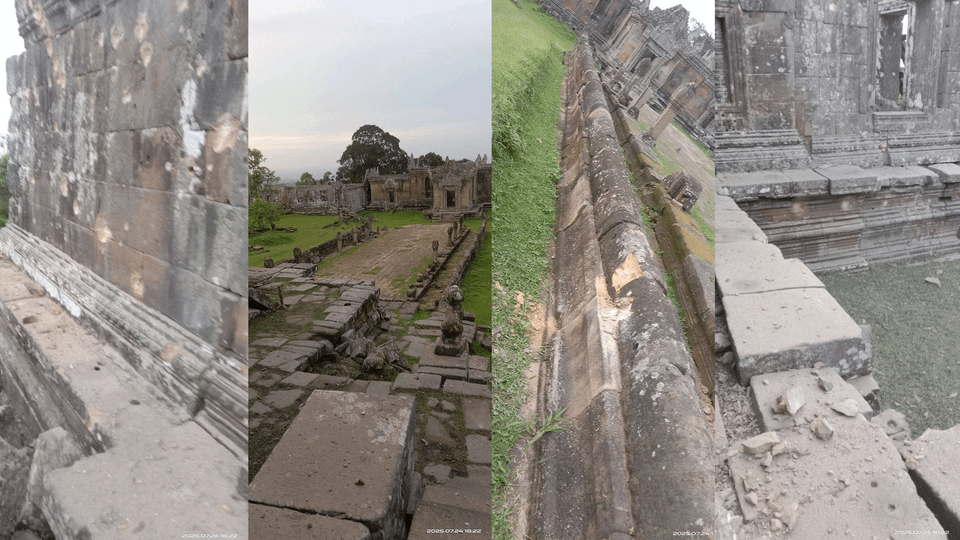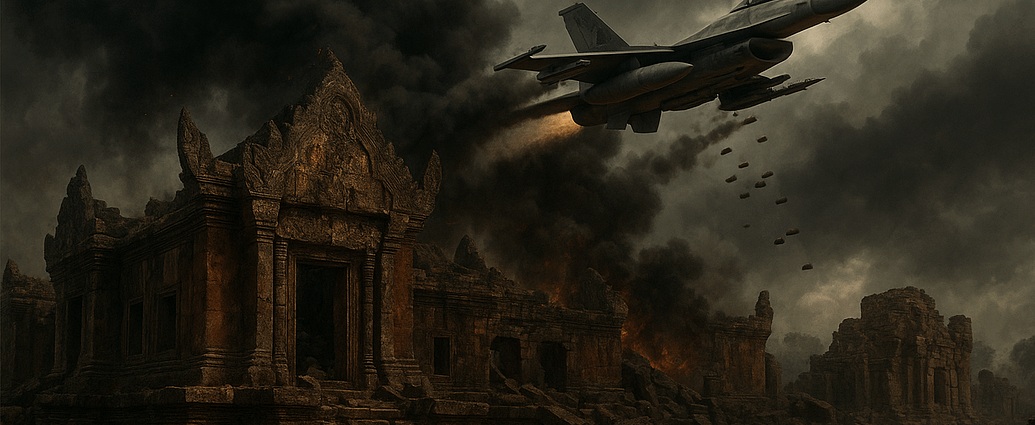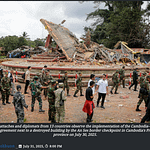The Cambodia-Thailand border conflict, reignited by a May 28, 2025, incident where a Khmer soldier was killed by a Thai soldier near Ta Moan Thom temple, has escalated into a severe humanitarian and legal crisis. Cambodia accuses Thailand of initiating hostilities with banned cluster munitions, targeting sacred sites, and endangering civilians—actions that breach international law. Tensions have surged further with Thailand’s deployment of heavy artillery and fighter jets, intensifying cross-border violence and displacing thousands. As Cambodia faces mounting casualties and destruction, Thailand’s disproportionate and aggressive response heightens the risk of all-out war, urgently demanding global accountability.

Roots of the Conflict
The 817-kilometer border, shaped by colonial-era treaties such as the 1904 Franco-Siamese Agreement, has long fueled disputes over Khmer temples, including Preah Vihear and Ta Moan Thom. A timeline of key events highlights this tension: in 1907, France and Thailand signed a border treaty; in 1954, Thailand occupied Preah Vihear temple; in 1962, the International Court of Justice (ICJ) ruled it belongs to Cambodia; and in 2008-2011, cross-firings near the temple killed dozens. The May 28, 2025, killing of a Cambodian soldier by Thai forces, followed by a leaked June 2025 phone call between former PM Hun Sen and Thai PM Paetongtarn Shinawatra—leading to her suspension—ignited the current crisis. On July 23, 2025, five Thai soldiers were injured by landmines near the Thai-Cambodian border. Thailand accused Cambodia of laying new mines, an allegation Cambodia denied, asserting that the explosives were remnants from its civil war during the 1980s and 1990s. In response, Thailand recalled its ambassador, expelled the Cambodian envoy, and closed several border crossings. Cambodia retaliated by withdrawing its diplomats and downgrading diplomatic relations to the lowest level. Clashes on July 24–28 spread to at least six locations and have since killed at least 43 Cambodians and Thais, mostly civilians, injured over 130 individuals, and displaced up to 300,000 people as of July 29, 2025. The ceasefire came on July 29 and was effective on July 29, 2025, bringing a temporary halt, though mistrust lingers. On July 30, 2025, Cambodian military officials escorted observers to a destroyed checkpoint in Preah Vihear province, alleging that Thai forces had “illegally captured 20 Cambodian soldiers” during recent clashes. According to reports, one soldier escaped, two are presumed dead and 17 are allegedly still in Thai custody. Cambodia condemns Thailand’s actions as violations of international humanitarian law, threatening ASEAN stability. The UN Charter (Article 2 (4)), prohibiting the use of force against territorial integrity, underscores Thailand’s obligation to seek peaceful resolutions.
Cluster Munitions: A Prohibited Weapon
The Convention on Cluster Munitions (CCM), adopted in 2008 and entered into force in 2010, bans the use, production, transfer, and stockpiling of cluster munitions due to their indiscriminate and long-lasting harm to civilians. These weapons, which release multiple explosive submunitions over wide areas, often leave unexploded ordnance that endangers lives, particularly those of farmers and children, long after conflicts end. Cambodia alleges that Thailand has deployed cluster munitions in Oddar Meanchey in 2011 and again in July 2025, violating the CCM, which both countries are urged to respect under international law. Reports highlight “indiscriminate harm” to villages, with lingering unexploded ordnance posing severe risks. Thailand’s reported claim of “military necessity” conflicts with the CCM’s absolute prohibition and the Geneva Conventions’ principle of proportionality, which mandates minimizing civilian harm.
Desecration of Cultural Heritage
Cambodia has accused Thailand of violating the 1954 Hague Convention for the Protection of Cultural Property in the Event of Armed Conflict by deploying F-16 fighter jets to conduct airstrikes near the UNESCO World Heritage-listed Preah Vihear Temple, causing significant damage to the temple and its surrounding areas, including access roads and ancient structures, since July 24, 2025. Cambodia’s Ministry of Culture condemned the strikes as a “cultural disaster and moral tragedy,” alleging they constitute “cultural genocide” due to the temple’s profound significance as a symbol of Khmer heritage. Thailand’s military claims the strikes targeted Cambodian military positions, such as the 8th and 9th Support Infantry Division Headquarters, but has not provided evidence to substantiate this, prompting accusations of deliberate disregard for international law. These actions have intensified nationalist tensions and sparked widespread outrage in both nations, with Cambodia appealing to the UN Security Council for intervention.
Civilian Toll and Displacement
The conflict has devastated civilians since May 2025. Thai airstrikes and artillery in Preah Vihear and Oddar Meanchey, alongside Cambodian shelling in Surin, have killed non-combatants, including an eight-year-old boy, and injured dozens. Over 130,000 Thais and 35,000 Cambodians have fled, with hospitals and schools, including a Surin school, destroyed by shelling. The 1949 Geneva Conventions, particularly Common Article 3 and Article 8 of the Fourth Convention, mandate distinguishing between combatants and civilians and prohibit attacks on civilian objects like homes, hospitals, and schools. Thailand’s use of superior firepower has intensified this humanitarian crisis, drawing condemnation from Cambodian officials and international observers.
Use of Aircraft to Deploy Toxic Smoke
Cambodia has accused Thailand of deploying toxic chemical agents via aircraft over civilian border villages in Oddar Meanchey since July 2025, causing widespread respiratory distress, environmental devastation, and civilian suffering. This alleged use of chemical weapons constitutes a grave violation of the 1997 Chemical Weapons Convention (CWC), an international treaty ratified by 193 states that prohibits the use, development, production, stockpiling, and transfer of chemical weapons (Chemical Weapons Convention, 1997). Specifically, Article I of the CWC explicitly bans the use of toxic chemicals to cause harm or death through inhalation or contact, a prohibition Cambodia claims Thailand has breached by targeting defenseless populations. Thailand strongly denies these allegations, labeling them as “fake news,” while eyewitness accounts from Oddar Meanchey describe a yellowish haze enveloping villages, leaving residents struggling to breathe and raising fears of war crimes that challenge the foundations of international humanitarian law, including the 1949 Geneva Conventions’ protections for civilians.
Ceasefire and Path to Lasting Peace
The ceasefire agreement, brokered by ASEAN on July 28, 2025, represents a critical step toward de-escalating the Cambodia-Thailand border conflict, but its success hinges on robust cooperation and transparency from both nations. A Malaysian-led delegation, appointed by ASEAN, has been tasked with overseeing the ceasefire’s implementation, monitoring compliance, and facilitating dialogue to address underlying tensions. To ensure lasting peace, Cambodia and Thailand must commit to several key measures. First, both nations should immediately withdraw heavy artillery and military personnel from the border zones, particularly near contested sites like Preah Vihear and Ta Moan Thom temples, to reduce the risk of renewed hostilities. Second, they must grant the Malaysian delegation unrestricted access to conflict zones in Preah Vihear, Oddar Meanchey, and Surin to verify compliance with the ceasefire, investigate allegations of cluster munitions and chemical weapons use, and assess damage to cultural heritage sites. Third, both countries should engage in regular, transparent negotiations mediated by the Malaysian team, focusing on clarifying border demarcations based on historical treaties and ICJ rulings, such as the 1962 Preah Vihear decision. Joint patrols and neutral monitoring mechanisms, supported by ASEAN and potentially UN observers, could further build trust. Cambodia and Thailand must also prioritize humanitarian aid, ensuring safe return for displaced civilians and providing medical and psychological support for those affected. Failure to cooperate fully with the Malaysian delegation risks undermining ASEAN’s credibility and could lead to further escalation, necessitating stronger intervention from the UN Security Council or the International Court of Justice. By adhering to these steps, both nations can transform the fragile ceasefire into a foundation for enduring peace and regional stability.
Demand for Accountability
The escalating use of illegal tactics—including cluster munitions, targeted attacks on UNESCO World Heritage Sites like the Preah Vihear Temple, civilian casualties, and the deployment of toxic chemical agents over populated areas—demands urgent and independent investigation. While ASEAN’s ceasefire, implemented on July 29, 2025, was a positive step, it has not been strong enough to secure lasting peace. The United Nations and the Organisation for the Prohibition of Chemical Weapons (OPCW) have called for immediate international intervention to uncover the truth, protect civilians, and safeguard irreplaceable cultural heritage. As human suffering intensifies and displacement continues to rise, sustained diplomatic efforts are more essential than ever to restore peace and regional stability.
Author Bio: In Sokhuon is a Cambodian research scholar pursuing a Ph.D. in International Relations and Politics at Mahatma Gandhi University, India.







